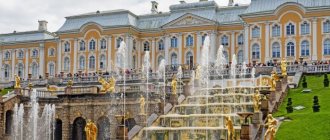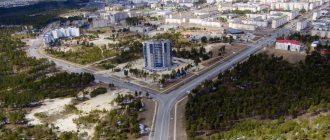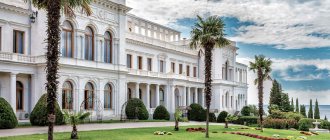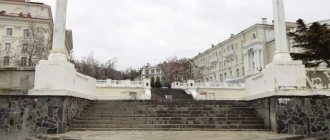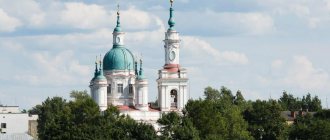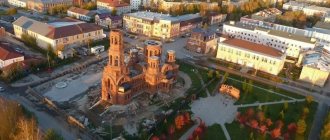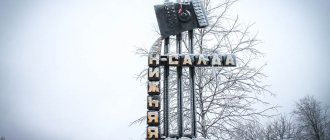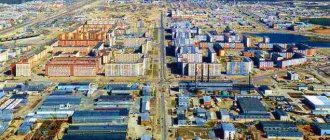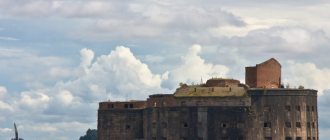Peterhof (“Peter’s courtyard”, from 1944 to 1997 - Petrodvorets) is a city in Russia, a municipal entity within the Petrodvortsovy district of the federal city of St. Petersburg. Located on the southern shore of the Gulf of Finland. A large tourist, scientific and educational center to the west of St. Petersburg, 29 km by rail.
Railway stations New Peterhof, Old Peterhof, University on the Baltic line of the October Railway. Marina on the Gulf of Finland.
Peterhof was founded in 1710 as an imperial country residence, and became a city in 1762. The city is home to a monument of world architecture and palace and park art of the 18th-19th centuries, the Peterhof Museum-Reserve. Science City since 2005.
Story
The emergence of a settlement
Until the beginning of the 18th century, on the site of Peterhof on the shores of the Gulf of Finland there were the Finnish villages of Kuusoya (Finnish kuusoja - spruce stream) and Pohjajoki (Finnish pohjajoki - northern river), to the south of them, on Popova Gora (now Babigon Heights), a village Papingondo.
For the first time, Peterhof (German: Peterhof - Petrov's yard) was mentioned in the traveling journal of Peter I in 1705 as a “travel yard” and a pier for moving to Kotlin Island. It was one of many manors (“passing houses”) built along the road from St. Petersburg along the southern shore of the Gulf of Finland. Here is the entry that appeared in the Journal of Peter I dated September 13, 1705:
“... our schnau “Munker” went to Petersburg, in the afternoon at 4 o’clock dropped anchor opposite Peterhof, and in the evening we arrived in Petersburg.”
In the 1710s, active landscape and architectural work began here on the construction of the estate of Peter I. In 1714, the Great Peterhof Palace, the Great Grotto with cascades, Monplaisir and other buildings in the Lower Park were founded. Gradually, near the construction of the residence, the Small Sloboda (to the south and southeast of the Upper Park) and the Big Sloboda (to the west, the so-called Old Peterhof, along modern Sobstvenny Avenue) appeared. Ships from Kronstadt and St. Petersburg arrived there, at the Merchants' Pier. In 1721, a water saw mill was founded, and with it a lapidary factory (now the Petrodvorets Watch Factory).
To supply the fountains of Peterhof, a special water pipeline with a total length of 40 km was built. Along its route there are 18 storage ponds containing more than 1.3 million cubic meters of water and covering an area of almost 100 hectares. The water pipeline was created in 1720-1721 according to the design of hydraulic engineer Vasily Tuvolkov. On August 9, 1721, water cannons operated on the principle of communicating vessels. By 1723, the formation of the palace and park ensemble was largely completed. By this time, the main planning elements of the Lower Park had been formed, the Grand Palace and Monplaisir Palace had been built, and a water supply system of fountains had been constructed.
Initially, the settlement at the Palace was built chaotically, and state peasants, who made up the majority of the settlement’s inhabitants, generally lived in dugouts. In the 1730s, thanks to the architect M. G. Zemtsov, Peterhof for the first time received a clear layout. He rebuilt a number of buildings, creating the Craftsman's Courtyard for the Petegof state peasants, and the Kavalersky Courtyard for the court servants.
In 1747, the reconstruction of the palace began, which was carried out according to the design of the architect B. F. Rastrelli. The central part of the palace was enlarged and two side wings were added, connected by galleries to the Church and Armorial buildings.
City
Since 1762, Peterhof has been a city under the jurisdiction of the Palace Department.
At the end of the 18th century, according to the designs of the architect Giacomo Quarenghi and the garden master James Meders, the landscape English Park was created, and the English Palace was built in the park.
This is how I. G. Georgi describes Peterhof in 1794:
“§ 1148. The settlement of Peterhof has a stone church, besides which there are only wooden, but such good buildings that it resembles a town. It contains the homes of some court people, stables, barns, etc. More than thirty cannons are placed on the high bank for use on court holidays.”
At the end of the 18th century, there were 57 philistine houses in the city, and in 1801 an ensemble of the first stone buildings was formed along Pravlenskaya Street. In addition to employees, free people, “philistines,” began to settle in it. In 1824, Alexander I ordered the reconstruction of “58 of the ugliest buildings at public expense” according to “exemplary designs” developed by V.P. Stasov, V. Gesta, L. Ruska. In the 19th - early 20th centuries, the Life Guards Horse Grenadier, Uhlan and Dragoon regiments, as well as the Caspian 148th Infantry Regiment, were stationed in the city. Since 1828, summer camp training for students of St. Petersburg military educational institutions took place in the vicinity of Peterhof.
In 1825, Emperor Nicholas I acquired the lands east of the Lower Park and gave them to his wife Alexandra Feodorovna, and they received the name “Her Majesty’s Own Dacha Alexandria.” Since 1826, the architect A. A. Menelas has laid out a landscape park here and built a two-story Cottage Palace. In 1830-1831, the Farmers' Palace was built in the park, and in 1835 the Gothic Chapel (architect K. Schinkel)
In the 1828-1830s, a complex of barracks for the Life Guards Uhlan Regiment was created south of St. Petersburg Avenue. In the 1830s, the leading architect of Peterhof was A. Charlemagne, who in the 1837-1840s created a complex of Gothic houses and a city ensemble with a fire station in front of the Upper Park.
In 1826 the menagerie was moved south of the English Park. The Yegerskaya Sloboda appeared nearby. According to the design of the architect I. Charlemagne, a military hospital was built on the territory of the settlement in 1840, and in 1848 the building of the Public Offices; in 1879, an almshouse appeared, built according to the design of N. Benoit.
At the same time, to the west of Peterhof, Nicholas I acquired the Naryshkins’ dacha; it became the estate of the Emperor’s daughter Maria Nikolaevna and her husband, the Duke of Leuchtenberg. Architect A. I. Stackenschneider built the country Leuchtenberg Palace here in the classicist style in 1839-1842. In addition to the palace, Stackenschneider erected the Kitchen and Chamberlain buildings, and in 1845-1846 a marble-covered Chapel. The Leuchtenberg landscape park was laid out around it.
In 1832 to 1857, to the south of the Upper Park, near the Olgin Pond, the Kolonistsky Park appeared. It was created according to the designs of the architect A. I. Stackenschneider, the garden master P. Erler and the engineer M. Pilsudski. In 1842-1844, the Tsaritsyn Pavilion (as a gift to the wife of Emperor Nicholas I, Alexandra Fedorovna) and the Olga Pavilion (for the daughter of Nicholas I, Olga Nikolaevna) appeared on the islands of the Olga Pond.
In 1836, the growing Malaya Sloboda was renamed St. Petersburg Forstadt. In 1850, N. Benois became the leading architect, having already built the Verkhnesadsky House (1847) and the Houses of Honor (1848). Among his subsequent buildings are: the Palace Hospital (1853), post office (1854), railway station (1857), stables (1852).
On November 13 (26), 1848, by decree of Emperor Nicholas I, the district government was moved from Oranienbaum to Peterhof. The city becomes the center of the Peterhof district of the St. Petersburg province.
In 1853-1857, at the expense of the famous entrepreneur A. Stieglitz, the Peterhof Railway was built with a length of 30 km - from St. Petersburg to New Peterhof. Before this, since the 1830s, a land steam locomotive traveled along the Peterhof Highway. In 1854-1857, construction of the Peterhof railway station was carried out. Regular train service began on July 22. The composition was nicknamed “Cuckoo”; tickets were sold by students living in the surrounding dachas; The driver and conductor were also supernumerary [style!].
At the end of the 19th century, two gymnasium buildings appeared in the city. In 1905, according to the design of V. Sultanov, the Cathedral of Saints Peter and Paul was erected on the shore of Olgin Pond, and opposite it - a small building of a parochial school.
During the First World War, the first, second and third schools of warrant officers were stationed in Peterhof.
Until 1917, Peterhof was one of the main summer imperial residences, which was inhabited mainly by palace servants, officers and soldiers of the Life Guards regiments.
Soviet period
In 1918, the former imperial palaces of Peterhof were turned into museums. On May 18, 1918, the first workers' tour took place through the halls of the Grand Palace. During the first summer of the museum's operation, more than two thousand workers visited it. Soon, in numerous buildings where courtiers and palace servants had previously lived, rest houses, sanatoriums, and children's institutions began to be opened; Children's playgrounds, reading rooms, and stages appeared in the parks.
In 1936, Peterhof was reassigned to the Leningrad City Council.
From September 23, 1941 to January 19, 1944, the city was occupied by German troops. On October 5, 1941, the Peterhof landing force (naval) was landed in Peterhof. The front line ran on the western border of the city along the defense line of the Oranienbaum bridgehead. As a result of military operations, the city was almost completely destroyed or burned. The ensemble of the Lower Park suffered the most. About 30 thousand objects of painting, decorative art and sculpture from the palace collections were destroyed or looted; fountains and water supply system are out of order; 10 thousand trees - more than one third of the green area - were cut down.
In 1944, Peterhof was renamed Petrodvorets, since the German name was difficult to perceive against the backdrop of the destruction left by the German army. In the same year, the restoration of the city, its palace and park ensemble and fountain system began. Leningrad architects A. A. Ol, V. M. Savkov, E. V. Kazanskaya, A. E. Gessen, sculptors V. L. Simonov, I. V. Krestovsky, N. V. Dadykin, I. I. Suvorov, V. V. Elonen and others, as well as a large team of master restorers. On May 17, 1964, on the day of the celebration of the 250th anniversary of Peterhof, the doors of the first recreated halls of the Grand Palace opened. The scale of destruction was so great that not all objects could be restored. Thus, the Nizhnyaya Dacha, which was badly damaged during the war, was demolished in the 1960s due to accidents; the Konstantinovsky and Farmersky palaces were deteriorating. In general, the appearance of the pre-war city was preserved, and new construction began. Small two- and three-story houses appeared on the main streets. Station Square and Sovetskaya Square were reconstructed. The factory of precision technical stones (former lapidary factory) was revived; Since 1954, the plant, which had previously produced watch stones, began producing wristwatches.
In the 1960s, construction of the scientific and educational campus of Leningrad State University began in Old Peterhof. The university's physics department was the first to be built in 1971. Then the main building of the Research Institute of Physics was erected, where research laboratories and other structural divisions of the faculty moved in 1971-1975. In the second half of the 70s, the departments of applied mathematics - control processes, mathematics and mechanics and chemistry moved to the new university complex. The Institute of Mathematics and Mechanics, the Astronomical Observatory and Computing Center, the Institute of Chemistry, and the Institute of Computational Mathematics and Control Processes received new buildings. Student dormitories and residential buildings for university employees were also built. The Military Electrical Engineering School named after A. A. Popov, now the Naval Institute of Radio Electronics named after A. A. Popov, is also transferred here. A. S. Popova (VMIRE).
In the 1960s and 1970s, mass housing construction began in the city. New neighborhoods with five to ten-story buildings, schools, and shopping centers have sprung up. Near the English Park, on the former Cadet Parade Ground, a new residential area with high-rise buildings has been created.
On November 26, 1973, by Decree of the Presidium of the Supreme Soviet of the USSR, the city of Petrodvorets was awarded the Order of the Badge of Honor for the great contribution of workers to the restoration and development of palaces, museums and parks and in connection with the 250th anniversary.
Modern period
Since 1990, the palaces and parks of Petrodvorets have been part of the artistic and architectural palace and park museum-reserve "Peterhof" and in the same year were included in the UNESCO World Heritage Site under the name "Historical Center of St. Petersburg and Associated Monument Complexes " In 1997, the Peterhof State Museum was included in the State Code of Especially Valuable Objects of the Cultural Heritage of the Peoples of Russia.
The rich scientific and cultural potential of Peterhof allowed it to receive the status of the first science city in the North-West of Russia. On July 23, 2005, the corresponding Resolution of the Government of the Russian Federation No. 449 was adopted.
In 2005, after restoration, the Tsaritsyn and Olgin pavilions in Kolonistsky Park were opened to visitors. In 2004, new museums were opened - the Bicycle Museum and the Museum of Imperial Yachts, and in 2007 - the Playing Card Museum.
City name
The name Peterhof (German: Peterhof - Petrov's yard) has been known since 1705. Initially, only the area of the Monplaisir Palace was called this way, but soon this name spread to the entire settlement. On January 27, 1944, the city was renamed Petrodvorets. The new name was essentially an incorrect translation of the old one into Russian. At the same time, the railway platforms New Peterhof and Old Peterhof were not renamed.
In 1997, amendments were made to the law “On the administrative-territorial structure of St. Petersburg”; Petrodvorets was divided into two parts - the city of Peterhof and the village of Strelna. However, no changes were made to the address classifier then, so in some documents the former name Petrodvorets was indicated, which was also indicated on geographical maps. Soon, the Legislative Assembly of St. Petersburg made an attempt to officially turn Petrodvorets into Peterhof at the federal level, but the Government of the Russian Federation explained in its response that the city of Petrodvorets is located on the territory of the city of St. Petersburg and the St. Petersburg authorities can rename Petrodvorets.
In May 2009, by order of the Committee on Land Resources and Land Management of St. Petersburg, the name “Petrodvorets” was replaced by “Peterhof” in the address classifier. In September 2009, the Federal Service for State Registration, Cadastre and Cartography decided to indicate the name Peterhof instead of Petrodvorets on all maps.
Coat of arms and flag of the city
See also: Coats of arms with monograms and letters
- The coat of arms of Peterhof (the imperial residence in the St. Petersburg province) was approved on March 12, 1831:
“In the scarlet shield there is a golden monogram image of the name of Peter I”
On December 24, 1998, the Peterhof Municipal Council, by resolution No. 43, approved the Regulations on the coat of arms and flag of the municipality. The symbols of the city are registered by the Heraldic Council under the President of the Russian Federation under No. 475. According to the text of the Regulations:
“The coat of arms of the Municipal Formation of the city of Peterhof is an image in a golden field of a heraldic shield of an azure (blue, light blue) battlement wall lined with gold, and on top of it a scarlet (red) pillar, encumbered with the gold monogram name of Peter 1 under a gold imperial crown with azure ribbons.”
- The flag of Peterhof was approved in 1998. According to the text of the same Regulation:
“The flag of the Municipal Formation of the city of Peterhof is a 3-color panel with a width to length ratio of 2:3 with equal vertical stripes located from the hoist, respectively, in golden, red and azure-blue colors, with a one-sided image in the middle, on the central red stripe of a golden crowned monogram named after Peter the Great under a golden imperial crown with azure-blue ribbons, as the main element of the Coat of Arms of the city of Peterhof. The overall height of the main element of the coat of arms is ½ the height of the flag.”
Peterhof
The territory on the site of Peterhof in the pre-Petrine era
The territories on the coast of the Gulf of Finland, in the Neva delta and near Lake Ladoga have been inhabited by Finno-Ugric tribes from time immemorial. In their language, this region was called Inkermaa (“beautiful land”). Already starting from the 10th century. it entered the possession of Veliky Novgorod, but remained a pagan, inaccessible region until the 17th century. The Novgorodians periodically repelled attacks from their German neighbors, the Swedes and Germans, and the most famous battle was the Battle of the Ice on April 5, 1242, with the participation of Prince Alexander Nevsky. In the next century, there were skirmishes with the Swedes, for whom the attempt to gain a foothold at the mouth of the Neva in the Landskrona fortress was ultimately unsuccessful.
The gradual strengthening of Moscow and the weakening of Novgorod under the control of mayors from among the boyar nobility led to the defeat of the Novgorodians in the Battle of Shelon in 1471 and the annexation of all the lands of the former veche republic to the Moscow principality. Among them was Inkermaa or, in the Swedish manner, Ingria. The land on which Peterhof later grew up was transferred first to the new mayor Ivan Geirot, and then to his associate A. V. Bestuzhev. The administrative center was moved to the new border princely fortress of Ivangorod, opposite the German Narva.
In 1617, possessions on the Neva were transferred to the Swedish crown under a peace treaty. The Moscow principality, devastated by the turmoil, could not resist this decision, and the Russians found themselves cut off from trade routes on the Baltic Sea. A close mentor of the Swedish king, Johann Skytte, was appointed governor of Ingria. Gradually, the Russian-speaking population was forced out of the Swedish province to the south, and Finnish settlements reappeared on the site of Russian villages located on the territory of the future Peterhof.
Revenge was taken only after the brilliant victory of Russian weapons in the Northern War under the leadership of Peter I. An interesting metamorphosis occurred with the name of the hill on which Petrodvorets was erected. Initially called Popova Gora, it began to be called Papigondo under the Swedes, and after the Russian victory over the Swedes, Peter named it in the Russian manner - “Babi Gon”, which gradually turned into the modern name Babigon Hill.
The emergence of the city and the origin of the name
Active construction along the shores of the Gulf of Finland began in the era of Peter the Great. On the site of former Finnish villages, “travel yards” and piers appeared, one of which was mentioned on July 12, 1705 in the emperor’s traveling journal under the name Peterhof. The origins of the name, which literally means “Peter’s Court” in Dutch, lie in the European toponymic tradition. It undoubtedly reflects the idea that Peter I had already had at that time to build his residence on this site.
In Peter’s times, the name Peterhof applied only to the palace complex, but by 1726, when an extensive infrastructure had developed around it and workers, engineers, peasants and military personnel settled, Peterhof acquired the status of a city.
Towards the end of World War II, on January 27, 1944, the city was renamed Petrodvorets in order to eliminate the obvious German-speaking sound. During the perestroika era, painful associations faded away, and in 1997, amendments to the law “On the administrative-territorial structure of St. Petersburg” divided Petrodvorets into the city of Peterhof and the village of Strelna.
Peterhof in the 18th century under Peter I
The official founding date of the city is 1705, when active landscape and architectural work began on the swampy coastal lowlands. The first wooden sovereign palace appeared in 1708, west of Marly, and existed until 1770. Peter's residence was located halfway between the new capital and Kronstadt under construction and was conceived as a symbol of victory in the war with Sweden and Russia's triumphant access to the Baltic Sea.
The architecture of the complex was not a simple imitation of modern European models, but was a striking example of the emerging original Russian art. Peterhof was conceived as a monument to the glory of Russian weapons, replete with many allegories that glorified the courage of Russian soldiers and ridiculed the enemy. Famous architects and sculptors M. Zemtsov, J. Leblon, N. Michetti, I. Braunstein, as well as engineer P. Saul and landscape architect L. Garnechfelst were involved in the project. Peter I himself actively participated in the development and discussion of the details of the project; many of the embodied artistic ideas belonged to him. Sometimes he specifically ordered architects to deviate from European standards in order to create unique creations.
The land plot was divided into the Upper Garden and the Lower Park, which were supposed to house numerous fountains. Such a plan was not typical for regular parks of that period. An unprecedented water pipeline from sources 22 miles from Peterhof and a system of powerful pumps were built especially for the unique water extravaganza.
The grand opening of the residence took place on August 15, 1723, 2 years before Peter’s death. It was a majestic celebration that found Russia at the peak of prosperity: victory in the Northern War was the last step to the status of an Empire. By the end of Peter's reign in Peterhof, the final layout of the Upper Garden and Lower Park, the palace with the Grand Cascade and the Canal, the Alley of Fountains, the Monplaisir and Marly palaces, as well as the Hermitage had already been completed.
Around Peter's residence, the estates of the closest imperial associates began to grow, among whom were Field Marshal J. Bruce and physician I. Blumentrost. In addition, the imperial palace ensemble was surrounded by residential settlements - Bolshaya (the future Old Peterhof) and Malaya. In 1721, the Peterhof Lapidary Factory was opened at the water mill, producing jewelry for the royal family. After the October Revolution, the enterprise was renamed the Petrodvorets Watch Factory. The famous watch brands “Zvezda”, “Pobeda” and “Raketa” originated from its lines.
Peterhof in the 18th century under the successors of Peter I
During the short reign of Catherine I, which lasted from 1725 to 1727, work continued in Peterhof to complete the already built palace complexes. In addition, new fountains “Triton”, “Favorite” and “Eve” appeared on the territory, and the empress herself served as the prototype for the latter. At the same time, large-scale construction of the Moncourage Palace began for the all-powerful favorite of the Peter the Great era, Prince A. D. Menshikov. However, this project of the famous architect M. Zemtsov was not completed - the disgraced minister went into exile in 1727.
Those around the new sovereign, young Peter II, were distinguished by extreme anti-Petrine and anti-Petersburg views, so the court soon returned to Moscow. For three long years it seemed that the star of northern Palmyra, and with it Peterhof, had finally set.
But already in 1730, with the accession of Empress Anna Ioannovna to the throne, the pendulum swung back, and the already experienced M. G. Zemtsov was again invited to Peterhof to continue construction work. The main merit of the architect was that, in addition to the construction of new palace fountains, he redesigned and streamlined the adjacent settlements and rebuilt some buildings into public premises: the Craftsman's Courtyard for peasants and the Cavalier's Courtyard for court servants. The vast territory that later became Alexandria and the English Park housed the imperial menagerie.
After the Palace Revolution of 1741, such famous architects as B. F. Rastrelli and B. Fok arrived in Peterhof, by order of Empress Elizabeth Petrovna. The English gardening style, which was gaining popularity, was reflected in the English Park designed by Giacomo Quarenghi and J. Meders. Elizabeth's successors on the throne, Catherine II and Paul I, also made a significant contribution to the expansion and decoration of the palace complex in Peterhof.
Peterhof in the 19th century
By the beginning of the 19th century. in the city adjacent to the palace there were already 57 philistine houses, 10 of them made of stone. Military personnel from the Life Guards of the Horse Grenadier, Uhlan and Dragoon regiments and the Caspian 148th Infantry Regiment were quartered in Peterhof. Lower court ranks and sailors lived in simple wooden houses. At the end of the 1820s. By order of Alexander I, dozens of the most unsightly buildings were rebuilt at public expense by famous metropolitan architects L. Ruska, V. Geste and V. Stasov. The city gradually expanded and became more comfortable.
In the years after the Napoleonic wars, the activity of the Cutting Factory temporarily fell into decline, but at the same time, its own paper production appeared in Petegrof.
The real flourishing of construction in Peterhof began after the accession of Nicholas I to the throne in 1825. The Tsar acquired the lands on which the menagerie of Anna Ioannovna's time was located and moved the animals to the English Park, thus freeing up the property for the construction of the Alexandria dacha, named after Empress Alexandra Feodorovna. The project, which resulted in a new landscape park and the Cottage Palace appearing in Peterhof, was led by the architect A. A. Menelas. In the 1830s. he was replaced by the architect I. Charlemagne, who rebuilt a number of Gothic houses and city buildings near the Upper Park. Along with this, local infrastructure developed: in the 1840s. A military hospital and government offices appeared in the city, and 30 years later - an almshouse designed by N. Benois. These objects were located on the territory of the so-called. Yegerskaya Sloboda, south of the English Park.
The traditions of A. Charlemagne to simultaneously develop both the palace and the city were continued by his follower A. I. Stackenschneider. Thanks, among other things, to their efforts, the expanded Peterhof received the status of a county town in 1849, however, it has always remained a quiet provincial oasis, dominated by private development. Second half of the 19th century. was marked by the appearance of many buildings in the classicist style, including the Palace of Leuchtenberg, erected for the daughter of Nicholas I, Maria, and her husband, the Duke of Leuchtenberg. At the same time, through the efforts of A. I. Stackenschneider, the German Colonist Park appeared, and on the islands of the Olgin Pond, picturesque pavilions grew up - Tsaritsyn and Olgin, in honor of the wife and daughter of the sovereign. The end of the century was crowned by the tireless activity of the talented architect N. Benois.
By 1836, Malaya Sloboda had become so enlarged that it was renamed St. Petersburg Forstadt (from the German “suburb”). By the end of the 19th century. in Peterhof there were already 387 residential buildings, of which only 70 were stone. The growth of the settlement was greatly facilitated by the branch of the Peterhof Railway, built in the 1850s. financed by the entrepreneur A. Stieglitz and connecting Peterhof with St. Petersburg. The opening of this section of the railway track took place on July 22, 1857, and by 1864 it was extended to Oranienbaum.
During the reign of Alexander III, the Peterhof complex was only slightly expanded, as the emperor preferred to spend time in Gatchina. Nevertheless, in 1885, the Lower Dacha appeared in Alexandria, designed by the architect A. Tomishko, which was intended for the prince, the future Nicholas II. In addition, at the end of the century, two gymnasiums were opened in Peterhof.
At the turn of the century, Nicholas II ordered the construction of barracks for the Dragoon and Caspian Infantry regiments. One of the most noticeable innovations for Peterhof and all of St. Petersburg was the power plant that grew to the west of Alexandria Park.
Peterhof / Petrodvorets in the 20th century
In 1905, the Orthodox Cathedral of Saints Peter and Paul was completed, built according to the design of the architect N.V. Sultanov, approved by Alexander III. The pyramidal temple, following the canons of Russian medieval architecture, became a picturesque dominant feature on the shore of Olga Pond.
With the Bolsheviks coming to power, the Peterhof palace and park ensemble was nationalized, and in 1918 the first excursions were held around the former imperial residence. By the mid-1920s. Peterhof's water supply system was put out of action due to financial difficulties and the devastating flood of 1924, which caused significant damage to the Lower Park. Reconstruction work, which continued until the war, helped restore some of the fountains and strengthen the structures of the Sea Canal and the Grand Cascade.
The living quarters, which were inhabited by palace servants, officers and soldiers, were gradually rebuilt into rest houses, sanatoriums and children's institutions.
The more than two-year period of fascist occupation, from September 1941 to the end of January 1944, caused enormous damage to Peterhof. The city was plundered and burned almost to the ground; about a third of the park trees were cut down and used to build anti-tank rubble. Many priceless works of art were stolen or destroyed, and only a small part of the park sculptures were removed from the palace park before the arrival of the Germans.
The restoration of Peterhof, to which the best forces of national culture were deployed after the war, continued until 1973. On November 26, 1973, the city was awarded the Order of the Badge of Honor in honor of the 250th anniversary and for the contribution of workers to the reconstruction of historical values and museum work. Outstanding Leningrad architects A. A. Ol, E. V. Kazanskaya, A. E. Gessen, sculptors V. L. Simonov, A. Gurzhiy, etc. took part in the restoration process. Already in 1946, 38 water cannons resumed operation in the central part of the palace complex, and in the 1950s. The central part of the city was replenished with new buildings and acquired a pre-war appearance. In 1954, the Peterhof Watch Factory was restarted. In subsequent decades, the city continued to grow through private development, including high-rise buildings, and came close to the railway track.
In the 1960s In Old Peterhof, construction began on buildings related to the educational and research structures of Leningrad State University. In 1971, the Faculty of Physics and the accompanying Research Institute of Physics were opened. In the second half of the 1970s. The scientific campus expanded to include the faculties of chemistry, applied mathematics and mechanical engineering. Research institutes engaged in scientific work in these areas and an astronomical observatory were built nearby. In the vicinity of the buildings, housing was also built for students, teachers and staff of scientific institutions.
Nowadays, the Peterhof Palace and Park Museum-Reserve, included in the UNESCO World Heritage List along with many other objects of the historical center of St. Petersburg, is a generally recognized tourist mecca. By the beginning of the 2000s. Most of the architectural monuments, such as the Belvedere, the Cottage in Alexandria, the Tsaritsyn and Olgin pavilions, and the regular layout of the Upper Garden and the Marlin ensemble of the Lower Park were completely restored. Delighted visitors are greeted by a real water extravaganza: there are a total of more than 170 fountains and 4 cascades in Peterhof. Many artistic treasures have been painstakingly reconstructed from surviving fragments, photographs and historical evidence. Large-scale restoration work continues to this day.
Coat of arms and flag of Peterhof
The modern coat of arms of the city, adopted by a resolution of the municipal council on December 24, 1998, is based on a historical design from 1831. Emperor Nicholas I personally approved the draft of the first official coat of arms of the Peterhof residence. The coat of arms depicts the gilded personal monogram of Peter I, composed of the first letters of the title Petrus Primus Imperator (“PPI”). Above it is the imperial crown.
Architecture and landmarks
State Museum-Reserve "Peterhof"
A monument of world architecture and palace and park art. It includes a palace and park ensemble of the 18th-19th centuries - a former country royal residence, turned into a museum after nationalization on May 19, 1918. The museum-reserve received its modern status in 1990.
The museum-reserve includes:
Palace and park ensemble "Peterhof"
- Great Peterhof Palace
The palace is the main building of the Peterhof palace and park ensemble. Initially, a rather modest royal palace, built in the “Petrine Baroque” style in 1714-1725 according to the Zh-B project. Leblond, and then N. Michetti, was rebuilt under Empress Elizabeth Petrovna in 1747-1752 according to the model of Versailles (architect F.-B. Rastrelli) - in the so-called mature Baroque style. 30 halls, including richly decorated state rooms, plastered to resemble marble, with painted ceilings, inlaid parquet and gilded walls.
- Upper Garden
The regular garden (15 hectares) south of the Grand Palace was laid out in 1714-1724 according to the plan of the architect B. Rastrelli. 5 ponds, fountains (5 fountains and a cascade: the Square Ponds fountains, the “Mezheumny”, “Oak” fountains and the “Neptune” fountain with the Apollo cascade), statues and trellis gazebos.
- Lower Park
The regular park (102 hectares) on the shore of the Gulf of Finland was modeled after the country residence of the French king Louis XIV in Versailles in the then fashionable French style. The sketches of Peter I served the architect I. Braunstein as material for drawing up the Master Plan of the residence. The sea canal from the Grand Palace to the bay cuts the park into two almost equal parts. The park contains several artistically completed architectural and park ensembles: the Grand Palace with a cascade, a canal and flower beds, the Large Greenhouse with an orchard and greenhouses, the Monplaisir Palace with a garden and greenhouses for herbs, the Marly Palace with vegetable gardens, orchards and fish ponds. However, the Lower Park of Peterhof became famous worldwide due to its unique and numerous fountains (more than 150 fountains and 4 cascades): the Great Cascade with the Samson fountain in front of it, the paired “Bowls” fountains, the “Marble Benches” and “Voronikha Colonnades” fountains, the Sea Canal with the Alley of Fountains, the Chess Mountain cascade, the Orangery fountain, Roman fountains, the Adam fountain, the Sheaf fountain and the Bells fountains, the Sun fountain, the Pyramid fountain, cracker fountains, the Lion cascades " and "Golden Mountain", the "Favorite" fountain, the "Eva" fountain, the "Whale" fountain, "Menazhernye" fountains, the "Clochy" fountains.
Alexandria Park
Palace and park ensemble "Alexandria"
Seaside landscape park (area 115 hectares) on the shore of the Gulf of Finland east of the Lower Park. It was laid out in 1826-1832 as a summer country residence of the family of Emperor Nicholas I by architects A. A. Menelas, A. I. Stackenschneider and garden master P. I. Erler.
- Palace Cottage (1826-1829, architect A. Menelas) is a small two-story building with an attic in the Gothic style. In 1842-1843, according to the design of the architect A. I. Stackenschneider, a dining room with a marble terrace was added to the Cottage.
- Farmers' Palace (1828-1831, architect A. Menelas) - a pavilion at a dairy farm for Grand Duke Alexander Nikolaevich. As a result of reconstruction by the architect A. I. Stackenschneider, it turned into a country palace in the neo-Gothic style and began to play the role of a summer country palace for the family of Alexander II.
- The Gothic Chapel (1830-1834, architect A. Menelas) is the Church of St. Alexander Nevsky, built in the Gothic style.
- Lower dacha of Nicholas II (late 19th century, architect A. Tomishko)
Colonial Park
A park in the south of the city with Olga's pond and pavilions in the style of the Italian Renaissance on artificial islands, laid out in 1838-1847 according to the design of architect A. I. Stackenschneider and garden master P. I. Erler.
- Tsaritsyn Pavilion (1839-1850, architect A. I. Stackenschneider) - built according to the type of ancient Roman villas discovered during the excavations of Pompeii, as a gift to the wife of Emperor Nicholas I, Alexandra Feodorovna.
- Olga Pavilion (1846-1848, architect A. I. Stackenschneider) is a strict three-story building on a powerful base in the style of southern Italian villas, built for the daughter of Nicholas I, Olga Nikolaevna.
Other attractions
Also among the city's attractions:
Parks and palace ensembles of the city
- Alexandrovsky Park
Landscape park (144 hectares) with ponds and islands south of Alexandria Park in the east of the city. It was laid out in 1832-1836 according to the design of architects A. A. Menelas, I. I. Charlemagne, and garden master P. I. Erler. Only the buildings of two guardhouses built in the 18th century have survived to this day.
- English park
The first landscape park of Peterhof with a pond, dams and bridges in the western part of the city. It was laid out in 1779-1790 according to the design of the architect J. Quarenghi and garden master James Meders, modeled on English estates. Quarenghi built the English Palace and the Birch Log House in the park, which were destroyed during the Great Patriotic War. Of all the buildings, only the greenhouses and the ruined bridge have survived.
- The English palace (1781-1796, architect G. Quarenghi) - in the style of strict classicism. The palace was destroyed during the Great Patriotic War. To this day, the ruins of the ground floor, where a memorial sign is installed, have been preserved. One of the capitals of the main portico is located in the Museum of the History of St. Petersburg in the Peter and Paul Fortress.
- Meadow Park
A park (85 hectares) without borders with a system of locks, canals and ponds along the line of the Samsonievsky water pipeline in the south of the city in the direction of Babigon (Nizino village). It was laid out in 1825-1857 according to the design of the architect A. I. Stackenschneider, the garden master P. I. Erler and the engineer M. I. Pilsudsky. From most of the buildings, including the Ozerki pavilion, only ruins remain. Almost 18 hectares of the Lugovoy Park territory are occupied by nine ponds - Bolshoi Zapasny (Nikolsky), Samsonovsky (Small Spare), Orlin, Ruinny, Krugly, Melnichny, Saperny, Babigonsky, Tserkovny. The water of these ponds is supplied through the Peterhof Canal to power the fountains and cascades of the Upper Garden and the Lower Park of Peterhof.) The park and its structures, which were badly damaged in 1941-1944, are gradually being restored. It is planned to restore the Nikolsky rural house near the Great Western Pond, the Ozerki pavilion at the beginning of the Samsonievsky water conduit, the Tsar’s Mill near the gateway on Samsonovsky Pond, and the “Ruins” on one of the islands of the Ruinny Pond.
- Belvedere (1852-1856, architect A. I. Stackenschneider) palace pavilion, located in the southernmost part of the park, on Babigonsky Hill. Intended for picnics of the imperial family. After the October Revolution, the palace pavilion became a workers' holiday home. During the Great Patriotic War, the palace pavilion was seriously damaged, and the sculptural groups disappeared forever. After restoration in 1953-1956, a rest house was opened again in the palace. Currently, serious restoration work is underway in the palace.
Features of the Belvedere: from the upper gallery you can see the Gulf of Finland, Kronstadt, St. Petersburg; in the 19th century there was a special lifting machine - a prototype of a modern elevator; the main entrance was decorated with sculptures exactly repeating those that stand today on the Anichkov Bridge.
- Oldenburgsky Park (1838-1839, architect V.P. Stasov, Znamenskaya Street, 29) - the former summer residence of Prince P.G. Oldenburgsky. All these buildings were destroyed, mostly during the war.
- The palace and park ensemble “Own Dacha” (1844-1850, architect A. I. Stackenschneider) is a combination of a regular and landscape park, a palace in the neo-Baroque style, the Holy Trinity Church in the Baroque style with one multifaceted dome.
- The Sergievka palace and park ensemble is the former estate of the daughter of Emperor Nicholas I, Maria Nikolaevna, and her husband, the Duke of Leuchtenberg. Architect A. I. Stackenschneider in 1839-1842 built a country palace for the Leuchtenbergskys here in the classicist style. In addition to the palace, Stackenschneider erected the Kitchen and Chamberlain buildings, and in 1845-1846 a marble-covered Chapel (not preserved). A landscape park was laid out around it.
- Palace and park ensemble "Znamenka".
- Palace and park ensemble "Mikhailovka".
PETERGOF
PETERGOF, a city in Russia, part of the Petrodvortsovy district of St. Petersburg. Us. 85.7 thousand people (2019). Located to the south. shore of the Finnish Hall. Baltic metro station (pier). There are 2 railway stations within the city limits (New Peterhof and Old Peterhof). The St. Petersburg – Sosnovy Bor highway passes through P.
Story
Until the beginning 18th century on the site of P. there were several Finnish settlements, including the chaplain's manor [Popova manor; name originated from the country residence of the chaplain of the Lutheran Church in Türis (Türö, now the Martyshkino district in the city of Lomonosov)]. In the beginning. 1704 in Popova Manor, Tsar Peter I began construction of a new “sovereign courtyard”. Since 1705, along with the name. Popova Manor, the name appears in the sources. Peterhof (Piterhof), finally established in the 1710s. In 1710, work began on the formation of a palace and park ensemble and the construction of the Grand Palace - a ceremonial country residence. Other developments in Petersburg took place to the west of the residence (the so-called Old Peterhof). In 1721, to decorate the interiors of the residence, a “water saw mill” was founded (since 1801 Lapidary Factory; since 1932 precision technical stones factory; since 1954 Petrodvorets Watch Factory) - a center for the production of products from jasper, marble, Ural malachite, Siberian jade, mosaics from colored stones. City since 1762. At 19 - beginning. 20th centuries The Horse Grenadier, Uhlan and Dragoon Life Guards regiments, as well as the 148th Infantry, were stationed in P. Caspian Regiment (preserved their military camps). In 1848–1923, a district town in the St. Petersburg province (in 1914 it was changed to Petrograd). In 1857, railway traffic was opened. line St. Petersburg - New Peterhof, in 1864 - New Peterhof - Oranienbaum (now Lomonosov).
By decree of the Provisional Government of July 15 (28), 1917, it was included in Petrograd. In 1918 former imp. palaces have been declared museums. In 1923–27 it was a provincial town in the Petrograd province (in 1924 it was renamed Leningradskaya). In 1930–36 as part of the Leningrad Suburban District of the Leningrad Region. Since 1936 it has been subordinate to the Leningrad City Council; since 1938, the administration of the Peterhof (in 1944 renamed Petrodvortsovy) district of Leningrad (since 1991 St. Petersburg) has been located in Petrograd. During the Great Patriotic War, on September 23, 1941, it was occupied by German troops. The front line ran along the western outskirts of the city, which was almost completely destroyed as a result of military operations. Liberated on January 19, 1944 during the Krasnoselsko-Ropshinskaya offensive operation. In 1944–2009 it was called Petrodvorets. In 1944, work began on the restoration of the city and its palace and park ensemble (project manager - architect A. A. Ol). In 2005–10 it had the status of a science city (not officially extended).
Architecture
The Great Palace from the Upper Garden. Photo by P. S. Pavlinov
The basis of the city is one of the largest palace and park ensembles in Russia from the 18th–19th centuries. (area St. 1.1 thousand hectares). Main composition. the idea of its central part belonged to Peter I. Under his personal control, the Grand Palace was built on a ledge facing the sea [1710–1717, architects I. F. Braunstein, J. B. Leblon and others; completed after the fire (1721) by 1723, architect. N. Michetti]. In 1746–54 it was rebuilt in Elizabethan Baroque forms according to the design of architect. B. F. Rastrelli; side wings were added, flanked by domed pavilions (the 5-domed Church of Saints Peter and Paul, 1747–51, and the “building under the coat of arms”). In 1779–85, a “building behind the coat of arms” was added to the west (architects Yu. M. Felten, I. E. Yakovlev; rebuilt in 1838–1840, architect I. I. Charlemagne). In 1846 the eastern one was built on. outbuilding (architect A.I. Stackenschneider). Most of the facades were restored by 1958 (project 1945, architects A. A. Ol, V. M. Savkov, E. V. Kazanskaya, A. E. Gessen, etc.).
Picture Hall of the Grand Palace.
The interiors of the palace preserved elements of decoration from the time of Peter I. In the beginning. 1750s 5 main halls were decorated (including the Dance Hall, 1751–52), a main staircase and suites of living rooms (gilded carvings, paintings by G. Valeriani, B. Tarsia, I. Ya. Vishnyakov, L. Werner, etc.; parquet etc.). In 1763–64, according to the designs of J. B. Vallin-Delamot, the Picture Hall was decorated with 368 portraits by P. Rotary; in 1766–69, the Chinese cabinets were decorated with lacquered panels and paintings by A. Perezinotti, br. I. I. and A. I. Belskikh and others. In the end. 1760s – 1770s In the style of classicism, according to the designs of Yu. M. Felten, the Chesme and Throne halls, the White dining room, and living quarters (including the Crown room) were decorated.
Big cascade. 1715–24. Architects J. B. Leblon, N. Michetti, M. G. Zemtsov. Photo by A. I. Nagaev
To the south of the palace there is a rectangular Upper Garden (1710–24, expanded in 1754–70s) with a regular system of alleys, pergolas, Square ponds (1719–20, designed by J.B. Leblon) and 5 fountains (including part “Neptune” with a German sculptural group from the 1650s, installed in 1798–99). To the north, on the side of the Gulf of Finland, there is an extensive regular Lower Park (area 102.5 hectares; 1710–40s, garden masters L. Garnihfelt, A. Borisov; in plan - 2 perpendicular tridents) with the largest world system of fountains (since 1720; 176 fountains; hydraulics - brothers Giuliano and Giovanni Barattini, P. J. Sualem, F. A. Strelnikov, etc.), for which a 22 km long water pipeline from the Ropshinsky springs was created (1720–21, engineer V. G. Tuvolkov), the New Connection Canal was dug (1832–33), as well as 18 reservoirs. Along the axis of the Grand Canal dug from the bay (1715–21) at the foot of the palace is the Grand Cascade (1715–24, architects Leblon, N. Michetti, M. G. Zemtsov; in the center is the sculpture “Samson tearing the mouth of a lion”, gilded bronze , 1801, sculptor M. I. Kozlovsky; stolen in 1942; recreated in 1947 by sculptors V. L. Simonov, N. V. Mikhailov) with a grotto (1716–20, rebuilt in 1859–60 according to the design of N. L. Benois) , bronze sculptures by F. I. Shubin, F. F. Shchedrin, I. P. Prokofiev, I. P. Martos, J. D. Rachette (all 1800–06, restored in 1947–1950 by sculptors N. V. Dadykin, I.V. Krestovsky, V.V. Ellonen), copies of antique statues by F.G. Gordeev, bas-reliefs by K.B. Rastrelli, G.K. Osner, F.P. Vassu, decorative vases (Kozlovsky, based on sketches by architect. A. N. Voronikhin). The lower platform in front of the cascade is limited by colonnade pavilions (1800–02, Voronikhin). To the east of the Grand Cascade is the “Chess Mountain” cascade (1721–26, design by Michetti, rebuilt in 1738–39 under the direction of Zemtsov; Italian sculptures of the 18th century) with 2 Rome. fountains (1738–39, architects I. Ya. Blank, I. Davydov; rebuilt in 1799–1800; bronze mascarons - 1817, according to the Martos model); to the west - the Golden Mountain cascade (Marlinsky cascade; 1722–25, architects Michetti, Zemtsov, T. N. Usov; completed in 1731–32; lined with marble in 1870) with 2 Menager fountains (1722–25), “Lion » cascade (1799–1801, Voronikhin, rebuilt in 1854–57, architect A. I. Stackenschneider; restored in 2000); also the fountains “Adam” (1721–1722) and “Eve” (1725–26, both by architect Michetti; sculptural copies of G. Bonazza, 1718, from originals by A. Rizzi), “Pyramid” (1721–24, Michetti; rebuilt in 1799–1800 according to the design of I. E. Yakovlev), joker fountains, etc.
On the shore of the Finnish Hall. there is the palace of Peter I “Monplaisir” (1714–23, architects I.F. Braunstein, J.B. Leblon, N. Michetti, T.N. Usov; based on the sketch of Peter I and, possibly, A. Schlüter) with interiors, decorated with exquisite simplicity (Lacquered cabinet with panels by G. Brumkorst, I. Tikhanov, P. Fedorov and others; wood carvings by N. Pino, paintings by F. Pilman, F. Vorobyov, M. Negrubov, S. Bushuev; approx. 140 paintings by Western European artists of the 17th–18th centuries), the Dutch Garden (1718, master L. Garnichfelt), the attached Assembly Hall (1726–32, M. G. Zemtsov), the Catherine Building (1747–49, B. F. Rastrelli, rebuilt in 1785–86, architect G. Quarenghi; restored in 1987). To the east of the Grand Canal there are also aviaries (1721–22, Michetti), the Great Orangery (1722–25, rebuilt in 1769–1770, architect I. E. Yakovlev). To the west of the Grand Canal are the Marly Palace, built in 1721–1723 according to Braunstein’s designs (rebuilt in 1898–99, architect A. I. Semenov) and the Hermitage pavilion, a labyrinth (1721), etc.
From last Thursday 18th century to the east and west of the original core of P., a complex of landscape parks with palaces and pavilions began to take shape. To the west of the Grand Palace there are parks: English (area 173 hectares; 1779–90, architect J. Quarenghi, gardeners J. Meders, W. Gould; ruins of the English Palace, 1781–94, Quarenghi), Prince P.G. Oldenburgsky (area 39 hectares; 1837–39, architect V.P. Stasov), Sergievka (area 173 hectares; since 1839; palace of Grand Princess Maria Nikolaevna and Duke M. Leuchtenberg - 1840–42, architect A . I. Stackenschneider, restored in 1965 and in 1971–74; now the Biological Institute of St. Petersburg State University), “Own dacha” (area 61 hectares; from the 1730s, redesigned in 1843– 54; palace of Prince A. G. Dolgorukov - presumably 1727–29, rebuilt in 1844–50, Stackenschneider, restored in 1955–63, architect I. N. Benois; Church of the Holy Trinity, 1858–1860, Stackenschneider) .
Gothic Chapel of St. Alexander Nevsky in Alexandria Park. 1831–34. Architects A. A. Menelas, I. I. Charlemagne, designed by K. F. Schinkel.
Belvedere Palace in Meadow Park. 1853–56. Architect A. I. Stackenschneider. Photo by D. V. Solovyov
From the east, the Lower Park of the Grand Palace is adjacent to the Alexandria Park (area 115 hectares; 1826–32, gardeners F. Vandelsdorf, P.I. Erler, etc.) with the imperial country house. Alexandra Feodorovna’s “Cottage” (1826–29), Guard House (1827), Ruin Bridge (1827–29, all by architect A. Menelas), Farmers’ Palace at the dairy farm of Tsarevich Alexander Nikolaevich (1828–31, Menelas; rebuilt in 1853–1859, architect A. I. Stackenschneider), Gothic Chapel of St. Alexander Nevsky (1831–34, architects Menelas, I. I. Charlemagne, designed by architect K. F. Schinkel, sculptures by V. I. Demut-Malinovsky ). To the south of it is Alexander Park (area 144 hectares; 1832–36, Menelas, Charlemagne, Erler). To the east along the bay are Znamenka parks (area 74 hectares; 1835–69, garden masters J. Bush, Erler and others; palace of Count A. G. Razumovsky, 1750–60s, rebuilt in 1856–60 , architect G. A. Bosse; Church of Saints Peter and Paul, consecrated in 1771; Chapel of St. Joseph, 1867, architect N. L. Benois) and Mikhailovka (area 106 hectares; 1830–40s , redesigned in 1859–62, architect Bosse, garden master N. Frost; palace of Grand Duke Mikhail Nikolaevich, 1858–61, architects Charlemagne, Bosse; now the Higher School of Management of St. Petersburg State University; center St. Equal to the Apostles Prince Olga, 1861–64, architect D. I. Grimm). Along the Samsonievsky Canal, south of the Grand Palace: Kolonistsky parks [pl. 29 hectares; 1838–47; on the islands of the Olgina pond (dug in 1837–38) - pavilions Tsaritsyn (1842–44) and Olgin (1846–47), both Stackenschneider] and Lugovoy (area approx. 85 hectares; 1835–57, Stackenschneider, engineer M I. Pilsudski; near the Babigonsky pond - the Belvedere Palace in the spirit of an ancient Greek temple, 1853–56, Stackenschneider). Palestine's palaces and parks are included in the World Heritage List.
The development of P. was ordered in 1732–39 under the direction of. M. G. Zemtsov, as well as according to the plan of 1848 (architect I. I. Charlemagne). Ch. highway – St. Petersburg Avenue, running parallel to the shore. Among the buildings in the classicist style, the following have been preserved: the building of the Peterhof Lapidary Factory (1777, Yu. M. Felten), an ensemble of six one-story Cavalry houses (1799–1801, F. P. Brower), the mansion of A. P. Strukov (1827–28, B . F. Fedoseev), adjutant house (1834–39, V. P. Stasov, Charlemagne). All R. 19th century the dacha of N.V. Vsevolozhsky (1836–38, G. Fossati) and the ensemble of houses near Alexandria Park (1837–44, Charlemagne) were built in the neo-Gothic style; palace stables (1847–1855), railway New Peterhof station (1854–57; all – architect N. L. Benois). Also the post office building (1850–54, architects A. Kavos, N.L. Benois), neo-baroque maids of honor buildings (1853–57; now the Benois Family Museum), waiter's house (1859–61, now the administration of the Petrodvorets district; both - architect N. L. Benois); estate of A.F. Geirot (1853, architect A.I. Stackenschneider), wooden. Khrushchev's house (1870–80s); The 5-domed Cathedral of Saints Peter and Paul in the Russian style (1895–1904, V. A. Kosyakov, designed by N. V. Sultanov), the building of the officers’ meeting of the Uhlan Regiment (1901–03, V. A. Crete), the Belley estate ( 1907–09, I. A. Pretro), neo-baroque military building. schools imp. Alexander II (1914, L. A. Ilyin; now the Military Naval Institute of Radio Electronics named after A. S. Popov). In the village Enlightenment (former village of Bobylskaya) – dachas of L. I. Krona (1891–92), M. N. Benois (1892, both with modern elements, architect L. N. Benois), c. St. Seraphim of Sarov (1904–06, architect N. N. Nikonov). In the end 1960s – 1980s built scientifically town of Leningrad State University (now St. Petersburg State University).
Monuments: led. book Alexandra Nikolaevna (1844–47, sculptor I. P. Vitali; recreated in 2000), builders of P. (1840s, architect A. I. Stackenschneider, installed in 1932), imp. Peter I (1884, sculptor M. M. Antokolsky; recreated in 1956), Memorial in memory of the defense of the city in 1941–44 (1961, architect T. N. Voronikhin and others; 1975, architect V. S. Maslov and etc.).
Centers of science and culture
In Petersburg there are a number of faculties, research institutes (including the V.V. Sobolev Astronomical Institute with an observatory) and the student campus of St. Petersburg. state university (the so-called Petrodvorets educational and scientific complex), branches of the military. universities of St. Petersburg. Artistic-architect. Palace and Park Museum-Reserve "Peterhof" [founded in 1918, modern. name since 1992; branches - museums of the Benois family (1988), wax figures (1990), collectors (2002; in the Verkhnesadsky house; including Russian painting of the 19th–20th centuries), bicycles, “Imper. yachts" (both 2004), playing cards (2007)].
Farm
In the urban economy, the leading role is played by the service sector (including education, trade, tourist services). Every year P. is visited by St. 6 million people (2018). The operating enterprises are: “Petrodvorets Watch Factory” (founded in 1721 as the “Peterhof Lapidary Factory”), “Industrial Accessories Factory” (production of hardware, fasteners, metal containers, etc.), and a reinforced concrete products factory.
Layout
The border of Peterhof runs from the intersection of Krylova Street with the waterline of the Gulf of Finland, then along the axis of the border with the village of Strelna to the south to the intersection with the border of the Lomonosovsky district of the Leningrad region, then to the west along the border of St. Petersburg with the Lomonosovsky district of the Leningrad region to the intersection with the border of the city of Lomonosov , further along the border with the city of Lomonosov to the intersection with the water's edge of the Gulf of Finland and further east along the water's edge of the Gulf of Finland to the intersection with the axis of Krylova Street..
The city of Peterhof consists of four historically established parts, which initially arose as settlements at the residence: Old Peterhof, Middle Peterhof, New Peterhof and Yegerskaya Sloboda.
